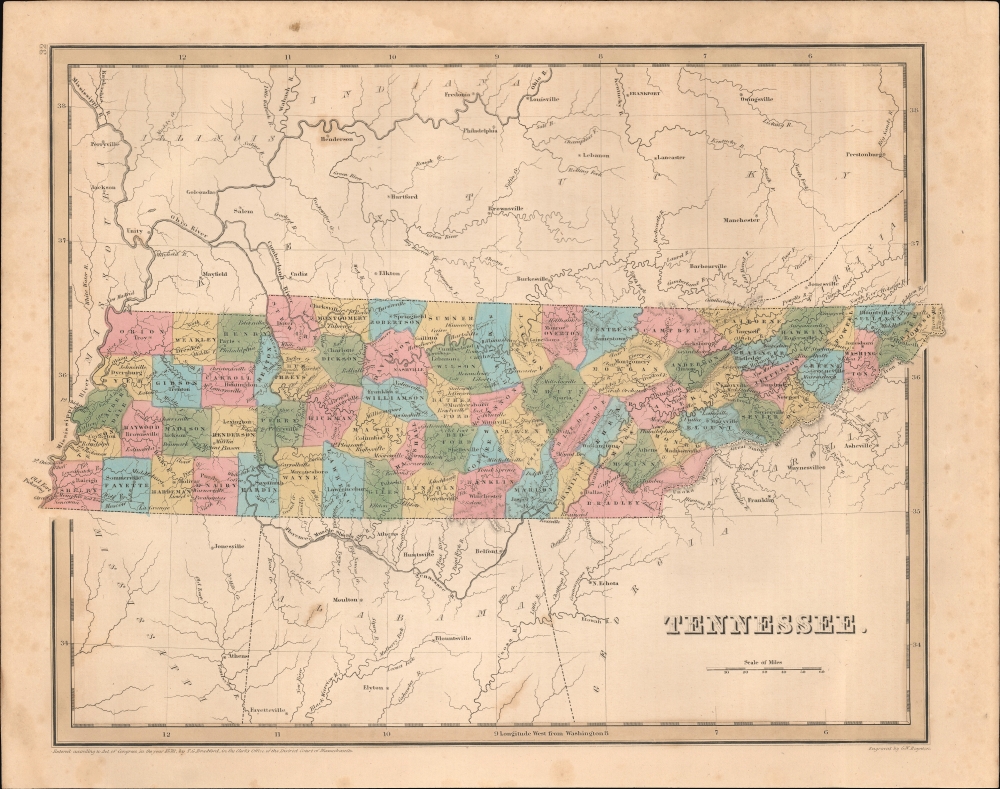
This item below is out of stock, but another example (left) is available. To view the available item, click "Details."
Details
1846 Bradford Map of Tennessee
1846 (dated) $300.00
1838 Bradford Map of Tennessee
Tennessee-bradford-1838
Title
1838 (dated) 12 x 14.5 in (30.48 x 36.83 cm) 1 : 2000000
Description
A Closer Look
The map embraces all of Tennessee as well as significant parts of adjacent states, particularly Kentucky. Here the state breaks the border of the map on both the east and west, allowing the cartographer to illustrate the state on the largest possible scale - given the page size. Tennessee in 1838 was rapidly growing, with new towns and settlements emerging constantly. Nonetheless, the state remained primary agricultural, with no railroad until Nashville and Chattanooga line of 1842.Historical Context - Slavery
Unlike many other southern states, Tennessee was not heavily dependent on slavery despite it still being part of the state's economy. This, and extensive migration from the north and east, fostered a growing abolitionist movement, with anti-slavery sentiment increasing in the state throughout the 1830s.Publication History and Census
This map was engraved by George Boynton in 1838 and published in the 1841 edition of Bradford and Goodrich's A Universal Illustrated Atlas. The map received regular updates through the late 1840s.CartographerS
Thomas Gamaliel Bradford (1802 - 1887) was born in Boston, Massachusetts, where he worked as an assistant editor for the Encyclopedia Americana. Bradford's first major cartographic work was his revision and subsequent republishing of an important French geography by Adrian Balbi, Abrege de Geographie published in America as Atlas Designed to Illustrate the Abridgment of Universal Geography, Modern and Ancient. Afterwards Bradford revised and expanded this work into his own important contributions to American cartography, the 1838 An Illustrated Atlas Geographical, Statistical and Historical of the United States and Adjacent Countries. Bradford's cartographic work is significant as among the first to record Texas as an independent nation. In his long career as a map publisher Bradford worked with William Davis Ticknor of Boston, Freeman Hunt of New York, Charles De Silver of Philadelphia, John Hinton, George Washington Boynton, and others. We have been able to discover little of Bradford's personal life. More by this mapmaker...
George Washington Boynton (fl. c. 1830 - 1850) was a Boston based cartographer and map engraver active in the first half of the 19th century. Boynton engraved and compiled maps for numerous publishers including Thomas Bradford, Nathaniel Dearborn, Daniel Adams, and S. G. Goodrich. His most significant work is most likely his engraving of various maps for Bradford's Illustrated Atlas, Geographical, Statistical, and Historical, of the United States and the Adjacent Countries and Universal Illustrated Atlas. He also engraved for the Boston Almanac. In 1835, Boynton is listed as an employee of the Boston Bewick Company, an engraving, stereotype, and printing concern based at no. 47 Court Street, Boston. Little else is known of his life. Learn More...

